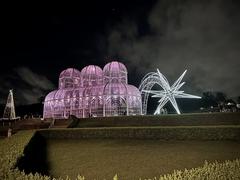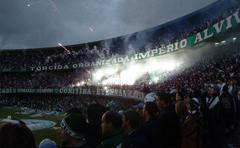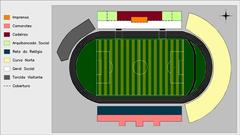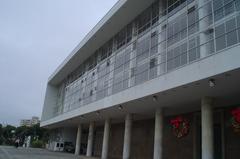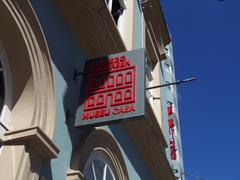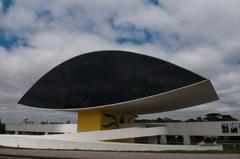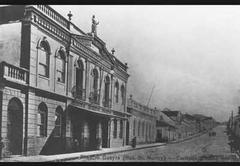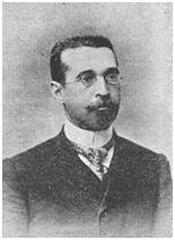
Igreja Ortodoxa São Jorge: Visiting Hours, Tickets, and Historical Significance in Curitiba, Brazil
Date: 04/07/2025
Introduction
The Igreja Ortodoxa São Jorge in Curitiba is a distinguished landmark that bridges faith, history, and culture. As one of southern Brazil’s most remarkable Orthodox churches, it encapsulates the legacy of the Syrian-Lebanese diaspora and serves as a vibrant hub for religious worship, intercultural exchange, and architectural appreciation. This comprehensive guide explores the church’s origins, cultural significance, architectural highlights, visitor information, and community role—making it indispensable for anyone interested in Curitiba’s diverse heritage or planning a visit.
(Vida Ortodoxa; Paraná Turismo; Gazeta do Povo)
Table of Contents
- Introduction
- Historical Background: Orthodox Christianity in Brazil
- Foundation and Development of Igreja Ortodoxa São Jorge
- The Significance of St. George in Orthodox Tradition
- Architectural and Artistic Highlights
- Visitor Information: Hours, Tickets, Tours, and Accessibility
- Community Role and Cultural Events
- Preservation, Recognition, and Modern Initiatives
- Frequently Asked Questions (FAQ)
- Explore More & Plan Your Visit
- References
Historical Background: Orthodox Christianity in Brazil
Orthodox Christianity in Brazil developed with successive immigration waves from Eastern Europe and the Middle East from the late 19th century onward. Communities from Lebanon, Syria, Greece, and Russia established Orthodox parishes, integrating their religious practices into Brazil’s multicultural society. The Antiochian Orthodox Church—under the Patriarchate of Antioch—emerged as a spiritual center for the Arab diaspora, particularly in southern cities like Curitiba (Vida Ortodoxa).
Foundation and Development of Igreja Ortodoxa São Jorge
The Igreja Ortodoxa São Jorge was founded in the early 1950s by Syrian and Lebanese immigrants intent on maintaining their spiritual and cultural identity in Brazil. The church’s cornerstone was laid in 1939, with completion and consecration in 1952–1953, making it one of Paraná’s oldest Orthodox churches (Paraná Turismo). Situated in the Mercês or Água Verde neighborhood (sources may vary), it soon became a beacon for Orthodox faithful and a focal point for the wider Arab-Brazilian community.
The dedication to St. George—a revered Christian martyr—mirrors the spiritual devotion and cultural traditions of its founding members, many of whom hailed from regions where St. George is especially venerated (Gazeta do Povo).
The Significance of St. George in Orthodox Tradition
St. George is celebrated across Christian denominations for his steadfast faith and legendary battle with the dragon, symbolizing the victory of good over evil. He is the patron saint of many countries and communities, including Brazil’s Orthodox Christians. His feast day—April 23 in the Western calendar and May 6 in the Eastern Orthodox tradition—is marked by processions, liturgies, and communal celebrations that affirm the community’s spiritual and cultural bonds (History Hit).
Architectural and Artistic Highlights
Exterior and Façade
The church’s architecture blends Byzantine inspiration with local craftsmanship. Notable features include:
- Central Dome: Symbolizing the heavens, visible from afar.
- Ornamental Arches and Columns: Echoing classic Orthodox design.
- Mosaics and Stonework: The façade displays mosaics of St. George slaying the dragon, a central icon of Orthodox art (Wikipedia).
Interior
- Iconostasis: A richly carved and gilded icon screen separates the nave from the sanctuary, featuring hand-painted icons of Christ, the Virgin Mary, and saints (Arquidiocese Ortodoxa).
- Frescoes and Stained Glass: Biblical scenes and saints adorn the walls and windows, bathing the interior in colorful, contemplative light.
- Liturgical Furnishings: Marble, woodwork, and gold leaf enhance the sacred atmosphere.
Community Contributions
The church’s construction and ongoing preservation reflect the dedication of local clergy and parishioners. It stands as a testament to the faith and resilience of the Arab-Brazilian Orthodox community (Sesc Paraná; Fotografando Curitiba).
Visitor Information: Hours, Tickets, Tours, and Accessibility
Location
- Address: Avenida Sete de Setembro, 4211, Água Verde (some sources note Mercês), Curitiba, Paraná, Brazil (Google Maps).
Visiting Hours
- Monday to Saturday: 9:00 AM – 5:00 PM
- Sunday: Divine Liturgy at 10:00 AM; open for visits until noon.
- Note: Hours may vary on holidays and during major festivals. Check the official parish website or Facebook page for up-to-date schedules.
Tickets and Admission
- Admission: Free. Donations are welcome to support church maintenance and community programs.
Guided Tours
- Availability: Guided tours are offered by appointment, especially on weekends or during festivals. Contact the parish office or use the official channels for booking.
Accessibility
- Ramps and designated seating areas are available. For specific needs, contact the church in advance.
Visitor Tips
- Dress Code: Modest attire is required. Avoid shorts and sleeveless tops.
- Photography: Permitted in most areas outside of services. Ask permission for photography during liturgies or of parishioners.
- Transport: Accessible by bus, taxi, or rideshare. Limited street parking, especially during events.
Community Role and Cultural Events
Beyond its religious function, the church is a vibrant center for Arab-Brazilian culture:
- Festa de São Jorge: Annual festival in April featuring liturgy, processions, Middle Eastern food, dance, and music (Bem Paraná).
- Educational Programs: Arabic language and catechism classes preserve heritage.
- Interfaith Dialogue: The church actively participates in citywide ecumenical initiatives, fostering religious pluralism (Curitiba Interfaith).
Preservation, Recognition, and Modern Initiatives
Igreja Ortodoxa São Jorge is recognized as a heritage site and is featured on local cultural tours. Regular restoration projects and community fundraising ensure its preservation for future generations (Patrimônio Curitiba). The church utilizes digital outreach and modern communication to engage new audiences, balancing tradition with contemporary relevance (Orthodox World).
Frequently Asked Questions (FAQ)
Q: What are the visiting hours for Igreja Ortodoxa São Jorge?
A: Monday to Saturday, 9:00 AM–5:00 PM; Sundays for service and visits until noon.
Q: Is there an entrance fee?
A: No, admission is free. Donations are appreciated.
Q: Are guided tours available?
A: Yes, by advance appointment. Contact the parish office or check online.
Q: Is the church accessible for people with disabilities?
A: Yes, ramps and accommodations are available. Please contact ahead for specific needs.
Q: Can I take photos inside the church?
A: Photography is allowed outside of services and in most areas. Always ask for permission during liturgies or when photographing people.
Q: What is the best time to visit?
A: During major feast days like St. George’s Day (April 23), Easter, or Christmas for a richer cultural experience.
Explore More & Plan Your Visit
Enhance your cultural experience in Curitiba:
- Attend the annual Festa Julina Árabe for a taste of Arab-Brazilian heritage (Bonde News).
- Explore Curitiba Tourism for travel planning.
- Download the Audiala app for interactive guides and audio tours.
Nearby Attractions: Museu Oscar Niemeyer, Botanical Garden, Praça do Japão, Mercado Municipal.
References
- Vida Ortodoxa
- Paraná Turismo
- Gazeta do Povo
- History Hit
- Orthodox World
- Arquidiocese Ortodoxa
- Bem Paraná
- Curitiba Turismo




